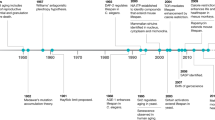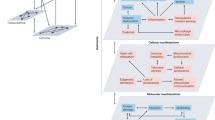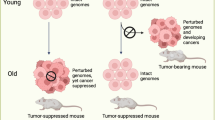Abstract
The engines that drive the complex process of aging are being identified by model-organism research, thereby providing potential targets and rationale for drug studies. Several studies of small molecules have already been completed in animal models with the hope of finding an elixir for aging, with a few compounds showing early promise. What lessons can we learn from drugs currently being tested, and which pitfalls can we avoid in our search for a therapeutic for aging? Finally, we must also ask whether an elixir for aging would be applicable to everyone, or whether we age differently, thus potentially shortening lifespan in some individuals.
This is a preview of subscription content, access via your institution
Access options
Subscribe to this journal
Receive 12 print issues and online access
$209.00 per year
only $17.42 per issue
Buy this article
- Purchase on Springer Link
- Instant access to full article PDF
Prices may be subject to local taxes which are calculated during checkout
Similar content being viewed by others
References
Rowe, J.W. & Kahn, R.L. Successful aging. Gerontologist 37, 433–440 (1997).
Kennedy, B.K. et al. Geroscience: linking aging to chronic disease. Cell 159, 709–713 (2014).
Salvioli, S. et al. Immune system, cell senescence, aging and longevity–inflamm-aging reappraised. Curr. Pharm. Des. 19, 1675–1679 (2013).
Miller, R.A. et al. An Aging Interventions Testing Program: study design and interim report. Aging Cell 6, 565–575 (2007).
Harrison, D.E. et al. Rapamycin fed late in life extends lifespan in genetically heterogeneous mice. Nature 460, 392–395 (2009).
Miller, R.A. et al. Rapamycin, but not resveratrol or simvastatin, extends life span of genetically heterogeneous mice. J. Gerontol. A Biol. Sci. Med. Sci. 66, 191–201 (2011).
Anisimov, V.N. et al. Rapamycin increases lifespan and inhibits spontaneous tumorigenesis in inbred female mice. Cell Cycle 10, 4230–4236 (2011).
Flynn, J.M. et al. Late-life rapamycin treatment reverses age-related heart dysfunction. Aging Cell 12, 851–862 (2013).
Wilkinson, J.E. et al. Rapamycin slows aging in mice. Aging Cell 11, 675–682 (2012).
Tardif, S. et al. Testing efficacy of administration of the antiaging drug rapamycin in a nonhuman primate, the common marmoset. J. Gerontol. A Biol. Sci. Med. Sci. 70, 577–587 (2015).
Lamming, D.W. et al. Rapamycin-induced insulin resistance is mediated by mTORC2 loss and uncoupled from longevity. Science 335, 1638–1643 (2012).
Roy, J., Paquette, J.-S., Fortin, J.-F. & Tremblay, M.J. The immunosuppressant rapamycin represses human immunodeficiency virus type 1 replication. Antimicrob. Agents Chemother. 46, 3447–3455 (2002).
Fang, Y. et al. Duration of rapamycin treatment has differential effects on metabolism in mice. Cell Metab. 17, 456–462 (2013).
Jagannath, C. & Bakhru, P. Rapamycin-induced enhancement of vaccine efficacy in mice. Methods Mol. Biol. 821, 295–303 (2012).
Mannick, J. B. et al. mTOR inhibition improves immune function in the elderly. Sci. Transl. Med. 6, 268ra179 (2014).
Selman, C. et al. Ribosomal protein S6 kinase 1 signaling regulates mammalian life span. Science 326, 140–144 (2009).
Wu, J.J. et al. Increased mammalian lifespan and a segmental and tissue-specific slowing of aging after genetic reduction of mTOR expression. Cell Rep. 4, 913–920 (2013).
Tsai, S. et al. Muscle-specific 4E–BP1 signaling activation improves metabolic parameters during aging and obesity. J. Clin. Invest. 125, 2952–2964 (2015).
Cornu, M., Albert, V. & Hall, M.N. mTOR in aging, metabolism, and cancer. Curr. Opin. Genet. Dev. 23, 53–62 (2013).
Campbell, R.K., White, J.R. & Saulie, B.A. Metformin: a new oral biguanide. Clin. Ther. 18, 360–371, discussion 359 (1996).
Bosi, E. Metformin–the gold standard in type 2 diabetes: what does the evidence tell us? Diabetes Obes. Metab. 11 Suppl 2, 3–8 (2009).
Martin-Montalvo, A. et al. Metformin improves healthspan and lifespan in mice. Nat. Commun. 4, 2192 (2013).
Andrzejewski, S., Gravel, S.-P., Pollak, M. & St-Pierre, J. Metformin directly acts on mitochondria to alter cellular bioenergetics. Cancer Metab. 2, 12 (2014).
Gandini, S. et al. Metformin and cancer risk and mortality: a systematic review and meta-analysis taking into account biases and confounders. Cancer Prev. Res. (Phila) 7, 867–885 (2014).
Zhou, G. et al. Role of AMP-activated protein kinase in mechanism of metformin action. J. Clin. Invest. 108, 1167–1174 (2001).
Cantó, C. et al. AMPK regulates energy expenditure by modulating NAD+ metabolism and SIRT1 activity. Nature 458, 1056–1060 (2009).
Jäger, S., Handschin, C., St-Pierre, J. & Spiegelman, B.M. AMP-activated protein kinase (AMPK) action in skeletal muscle via direct phosphorylation of PGC-1a. Proc. Natl. Acad. Sci. USA 104, 12017–12022 (2007).
Mair, W. et al. Lifespan extension induced by AMPK and calcineurin is mediated by CRTC-1 and CREB. Nature 470, 404–408 (2011).
Apfeld, J., O'Connor, G., McDonagh, T., DiStefano, P.S. & Curtis, R. The AMP-activated protein kinase AAK-2 links energy levels and insulin-like signals to lifespan in C. elegans. Genes Dev. 18, 3004–3009 (2004).
Greer, E.L. et al. An AMPK-FOXO pathway mediates longevity induced by a novel method of dietary restriction in C. elegans. Curr. Biol. 17, 1646–1656 (2007).
Viollet, B. et al. The AMP-activated protein kinase a2 catalytic subunit controls whole-body insulin sensitivity. J. Clin. Invest. 111, 91–98 (2003).
Kobilo, T. et al. AMPK agonist AICAR improves cognition and motor coordination in young and aged mice. Learn. Mem. 21, 119–126 (2014).
Kalender, A. et al. Metformin, independent of AMPK, inhibits mTORC1 in a rag GTPase-dependent manner. Cell Metab. 11, 390–401 (2010).
Check Hayden, E. Anti-ageing pill pushed as bona fide drug. Nature 522, 265–266 (2015).
Howitz, K.T. et al. Small molecule activators of sirtuins extend Saccharomyces cerevisiae lifespan. Nature 425, 191–196 (2003).
Baur, J.A. et al. Resveratrol improves health and survival of mice on a high-calorie diet. Nature 444, 337–342 (2006).
Wood, J.G. et al. Sirtuin activators mimic caloric restriction and delay ageing in metazoans. Nature 430, 686–689 (2004).
Pearson, K.J. et al. Resveratrol delays age-related deterioration and mimics transcriptional aspects of dietary restriction without extending life span. Cell Metab. 8, 157–168 (2008).
Jimenez-Gomez, Y. et al. Resveratrol improves adipose insulin signaling and reduces the inflammatory response in adipose tissue of rhesus monkeys on high-fat, high-sugar diet. Cell Metab. 18, 533–545 (2013).
Fiori, J.L. et al. Resveratrol prevents b-cell dedifferentiation in nonhuman primates given a high-fat/high-sugar diet. Diabetes 62, 3500–3513 (2013).
Mattison, J.A. et al. Impact of caloric restriction on health and survival in rhesus monkeys from the NIA study. Nature 489, 318–321 (2012).
Lagouge, M. et al. Resveratrol improves mitochondrial function and protects against metabolic disease by activating SIRT1 and PGC-1a. Cell 127, 1109–1122 (2006).
Sayin, O., Arslan, N. & Guner, G. The protective effects of resveratrol on human coronary artery endothelial cell damage induced by hydrogen peroxide in vitro. Acta Clin. Croat. 51, 227–235 (2012).
Timmers, S. et al. Calorie restriction-like effects of 30 days of resveratrol supplementation on energy metabolism and metabolic profile in obese humans. Cell Metab. 14, 612–622 (2011).
Burnett, C. et al. Absence of effects of Sir2 overexpression on lifespan in C. elegans and Drosophila. Nature 477, 482–485 (2011).
Kaeberlein, M. et al. Substrate-specific activation of sirtuins by resveratrol. J. Biol. Chem. 280, 17038–17045 (2005).
Beher, D. et al. Resveratrol is not a direct activator of SIRT1 enzyme activity. Chem. Biol. Drug Des. 74, 619–624 (2009).
Borra, M.T., Smith, B.C. & Denu, J.M. Mechanism of human SIRT1 activation by resveratrol. J. Biol. Chem. 280, 17187–17195 (2005).
Kulkarni, S.S. & Cantó, C. The molecular targets of resveratrol. Biochim. Biophys. Acta 1852, 1114–1123 (2015).
Woods, J.A., Wilund, K.R., Martin, S.A. & Kistler, B.M. Exercise, Inflammation and Aging. Aging Dis. 3, 130–140 (2012).
Bruunsgaard, H. et al. A high plasma concentration of TNF-α is associated with dementia in centenarians. J. Gerontol. A Biol. Sci. Med. Sci. 54, M357–M364 (1999).
Bruunsgaard, H., Skinhøj, P., Pedersen, A.N., Schroll, M. & Pedersen, B.K. Ageing, tumour necrosis factor-alpha (TNF-α) and atherosclerosis. Clin. Exp. Immunol. 121, 255–260 (2000).
Strong, R. et al. Nordihydroguaiaretic acid and aspirin increase lifespan of genetically heterogeneous male mice. Aging Cell 7, 641–650 (2008).
Weiss, H.J. The discovery of the antiplatelet effect of aspirin: a personal reminiscence. J. Thromb. Haemost. 1, 1869–1875 (2003).
Shoelson, S.E., Lee, J. & Goldfine, A.B. Inflammation and insulin resistance. J. Clin. Invest. 116, 1793–1801 (2006).
Koska, J. et al. The effect of salsalate on insulin action and glucose tolerance in obese non-diabetic patients: results of a randomised double-blind placebo-controlled study. Diabetologia 52, 385–393 (2009).
Baron, S.H. Salicylates as hypoglycemic agents. Diabetes Care 5, 64–71 (1982).
Goldfine, A.B. et al. Salicylate (salsalate) in patients with type 2 diabetes: a randomized trial. Ann. Intern. Med. 159, 1–12 (2013).
Yuan, M. et al. Reversal of obesity- and diet-induced insulin resistance with salicylates or targeted disruption of Ikkβ. Science 293, 1673–1677 (2001).
Zhang, G. et al. Hypothalamic programming of systemic ageing involving IKK-β, NF-κB and GnRH. Nature 497, 211–216 (2013).
Melnyk, A. & Himms-Hagen, J. Resistance to aging-associated obesity in capsaicin-desensitized rats one year after treatment. Obes. Res. 3, 337–344 (1995).
Riera, C.E. et al. TRPV1 pain receptors regulate longevity and metabolism by neuropeptide signaling. Cell 157, 1023–1036 (2014).
Park, T.J. et al. Selective inflammatory pain insensitivity in the African naked mole-rat (Heterocephalus glaber). PLoS Biol. 6, e13 (2008).
Kim, E.B. et al. Genome sequencing reveals insights into physiology and longevity of the naked mole rat. Nature 479, 223–227 (2011).
Bigal, M.E. & Walter, S. Monoclonal antibodies for migraine: preventing calcitonin gene-related peptide activity. CNS Drugs 28, 389–399 (2014).
Holzenberger, M. et al. IGF-1 receptor regulates lifespan and resistance to oxidative stress in mice. Nature 421, 182–187 (2003).
Xu, J. et al. Longevity effect of IGF-1R+/− mutation depends on genetic background-specific receptor activation. Aging Cell 13, 19–28 (2014).
Taguchi, A., Wartschow, L.M. & White, M.F. Brain IRS2 signaling coordinates life span and nutrient homeostasis. Science 317, 369–372 (2007).
Selman, C. et al. Evidence for lifespan extension and delayed age-related biomarkers in insulin receptor substrate 1 null mice. FASEB J. 22, 807–818 (2008).
Blüher, M. Extended longevity in mice lacking the insulin receptor in adipose tissue. Science 299, 572–574 (2003).
Foukas, L.C. et al. Long-term p110a PI3K inactivation exerts a beneficial effect on metabolism. EMBO Mol. Med. 5, 563–571 (2013).
Ortega-Molina, A. et al. Pten positively regulates brown adipose function, energy expenditure, and longevity. Cell Metab. 15, 382–394 (2012).
Nojima, A. et al. Haploinsufficiency of Akt1 prolongs the lifespan of mice. PLoS ONE 8, e69178 (2013).
Brown-Borg, H.M., Borg, K.E., Meliska, C.J. & Bartke, A. Dwarf mice and the ageing process. Nature 384, 33 (1996).
Flurkey, K., Papaconstantinou, J., Miller, R.A. & Harrison, D.E. Lifespan extension and delayed immune and collagen aging in mutant mice with defects in growth hormone production. Proc. Natl. Acad. Sci. USA 98, 6736–6741 (2001).
Flurkey, K., Papaconstantinou, J. & Harrison, D.E. The Snell dwarf mutation Pit1dw can increase life span in mice. Mech. Ageing Dev. 123, 121–130 (2002).
Coschigano, K.T., Clemmons, D., Bellush, L.L. & Kopchick, J.J. Assessment of growth parameters and life span of GHR/BP gene-disrupted mice. Endocrinology 141, 2608–2613 (2000).
Sun, L. Y. et al. Growth hormone-releasing hormone disruption extends lifespan and regulates response to caloric restriction in mice. eLife 2, e01098 (2013).
Zhang, Y. et al. The starvation hormone, fibroblast growth factor-21, extends lifespan in mice. ELife Sci. 1, e00065 (2012).
Kurosu, H. et al. Suppression of aging in mice by the hormone klotho. Science 309, 1829–1833 (2005).
Kuro-o, M. et al. Mutation of the mouse klotho gene leads to a syndrome resembling ageing. Nature 390, 45–51 (1997).
Shiozaki, M. et al. Morphological and biochemical signs of age-related neurodegenerative changes in klotho mutant mice. Neuroscience 152, 924–941 (2008).
Potthoff, M.J., Kliewer, S.A. & Mangelsdorf, D.J. Endocrine fibroblast growth factors 15/19 and 21: from feast to famine. Genes Dev. 26, 312–324 (2012).
Yie, J. et al. FGF21 N- and C-termini play different roles in receptor interaction and activation. FEBS Lett. 583, 19–24 (2009).
Conover, C.A. PAPP-A: a new anti-aging target? Aging Cell 9, 942–946 (2010).
Conover, C.A. & Bale, L.K. Loss of pregnancy-associated plasma protein A extends lifespan in mice. Aging Cell 6, 727–729 (2007).
Conover, C.A. et al. Longevity and age-related pathology of mice deficient in pregnancy-associated plasma protein-A. J. Gerontol. A Biol. Sci. Med. Sci. 65, 590–599 (2010).
Harrington, S.C., Simari, R.D. & Conover, C.A. Genetic deletion of pregnancy-associated plasma protein-A Is associated with resistance to atherosclerotic lesion development in apolipoprotein E–deficient mice challenged with a high-fat diet. Circ. Res. 100, 1696–1702 (2007).
Tanner, S.J., Hefferan, T.E., Rosen, C.J. & Conover, C.A. Impact of pregnancy-associated plasma protein-A deletion on the adult murine skeleton. J. Bone Miner. Res. 23, 655–662 (2008).
Adams, A.C. et al. LY2405319, an engineered FGF21 variant, improves the metabolic status of diabetic monkeys. PLoS ONE 8, e65763 (2013).
Gaich, G. et al. The effects of LY2405319, an FGF21 analog, in obese human subjects with type 2 diabetes. Cell Metab. 18, 333–340 (2013).
Smith, R. et al. FGF21 can be mimicked in vitro and in vivo by a novel anti-FGFR1c/β-klotho bispecific protein. PLoS ONE 8, e61432 (2013).
Johnson, J.E. & Johnson, F.B. Methionine restriction activates the retrograde response and confers both stress tolerance and lifespan extension to yeast, mouse and human cells. PLoS ONE 9, e97729 (2014).
Cabreiro, F. et al. Metformin retards aging in C. elegans by altering microbial folate and methionine metabolism. Cell 153, 228–239 (2013).
Grandison, R.C., Piper, M.D.W. & Partridge, L. Amino-acid imbalance explains extension of lifespan by dietary restriction in Drosophila. Nature 462, 1061–1064 (2009).
Miller, R.A. et al. Methionine-deficient diet extends mouse lifespan, slows immune and lens aging, alters glucose, T4, IGF-I and insulin levels, and increases hepatocyte MIF levels and stress resistance. Aging Cell 4, 119–125 (2005).
Richie, J.P. et al. Methionine restriction increases blood glutathione and longevity in F344 rats. FASEB J. 8, 1302–1307 (1994).
Komninou, D., Leutzinger, Y., Reddy, B.S. & Richie, J.P. Jr. Methionine restriction inhibits colon carcinogenesis. Nutr. Cancer 54, 202–208 (2006).
McCarty, M.F., Barroso-Aranda, J. & Contreras, F. The low-methionine content of vegan diets may make methionine restriction feasible as a life extension strategy. Med. Hypotheses 72, 125–128 (2009).
Kabil, H., Kabil, O., Banerjee, R., Harshman, L.G. & Pletcher, S.D. Increased transsulfuration mediates longevity and dietary restriction in Drosophila. Proc. Natl. Acad. Sci. USA 108, 16831–16836 (2011).
Hine, C. et al. Endogenous hydrogen sulfide production is essential for dietary restriction benefits. Cell 160, 132–144 (2015).
Miller, D.L. & Roth, M.B. Hydrogen sulfide increases thermotolerance and lifespan in Caenorhabditis elegans. Proc. Natl. Acad. Sci. USA 104, 20618–20622 (2007).
Ali, M.Y. et al. Regulation of vascular nitric oxide in vitro and in vivo; a new role for endogenous hydrogen sulphide? Br. J. Pharmacol. 149, 625–634 (2006).
Marcolin, E. et al. Methionine- and choline-deficient diet induces hepatic changes characteristic of non-alcoholic steatohepatitis. Arq. Gastroenterol. 48, 72–79 (2011).
Weaver, I.C.G. et al. Reversal of maternal programming of stress responses in adult offspring through methyl supplementation: altering epigenetic marking later in life. J. Neurosci. 25, 11045–11054 (2005).
Liao, C.-Y., Johnson, T.E. & Nelson, J.F. Genetic variation in responses to dietary restriction—an unbiased tool for hypothesis testing. Exp. Gerontol. 48, 1025–1029 (2013).
de Cabo, R., Carmona-Gutierrez, D., Bernier, M., Hall, M.N. & Madeo, F. The search for antiaging interventions: from elixirs to fasting regimens. Cell 157, 1515–1526 (2014).
Walter, S. et al. A genome-wide association study of aging. Neurobiol. Aging 32, 2109.e15–28 (2011).
Jeck, W.R., Siebold, A.P. & Sharpless, N.E. Review: a meta-analysis of GWAS and age-associated diseases. Aging Cell 11, 727–731 (2012).
Willcox, B.J. et al. FOXO3A genotype is strongly associated with human longevity. Proc. Natl. Acad. Sci. USA 105, 13987–13992 (2008).
Bollati, V. et al. Decline in genomic DNA methylation through aging in a cohort of elderly subjects. Mech. Ageing Dev. 130, 234–239 (2009).
Zampieri, M. et al. Reconfiguration of DNA methylation in aging. Mech. Ageing Dev. doi:10.1016/j.mad.2015.02.002 (20 February 2015).
Lawton, K.A. et al. Analysis of the adult human plasma metabolome. Pharmacogenomics 9, 383–397 (2008).
Zapata, H.J. & Quagliarello, V.J. The microbiota and microbiome in aging: potential implications in health and age-related diseases. J. Am. Geriatr. Soc. 63, 776–781 (2015).
Tilg, H. & Kaser, A. Gut microbiome, obesity, and metabolic dysfunction. J. Clin. Invest. 121, 2126–2132 (2011).
Xue, Q.-L., Bandeen-Roche, K., Varadhan, R., Zhou, J. & Fried, L.P. Initial Manifestations of frailty criteria and the development of frailty phenotype in the Women's Health and Aging Study II. J. Gerontol. A Biol. Sci. Med. Sci. 63, 984–990 (2008).
Rowe, J.W., Minaker, K.L., Pallotta, J.A. & Flier, J.S. Characterization of the insulin resistance of aging. J. Clin. Invest. 71, 1581–1587 (1983).
Fink, R.I., Kolterman, O.G., Griffin, J. & Olefsky, J.M. Mechanisms of insulin resistance in aging. J. Clin. Invest. 71, 1523–1535 (1983).
López-Otín, C., Blasco, M.A., Partridge, L., Serrano, M. & Kroemer, G. The hallmarks of aging. Cell 153, 1194–1217 (2013).
Narici, M.V., Maganaris, C.N., Reeves, N.D. & Capodaglio, P. Effect of aging on human muscle architecture. J. Appl. Physiol. 95, 2229–2234 (2003).
Lamberts, S.W., van den Beld, A.W. & van der Lely, A.J. The endocrinology of aging. Science 278, 419–424 (1997).
Acknowledgements
We apologize to those investigators whose important work we were unable to cite or describe in depth, owing to the limited scope and space constraints of this Perspective. We are supported by the Howard Hughes Medical Institute, the Glenn Center for Research on Aging and the American Diabetes Association Pathway to Stop Diabetes (grant no. 1-15-INI-12 (CER)).
Author information
Authors and Affiliations
Corresponding author
Ethics declarations
Competing interests
The authors declare no competing financial interests.
Rights and permissions
About this article
Cite this article
Riera, C., Dillin, A. Can aging be 'drugged'?. Nat Med 21, 1400–1405 (2015). https://doi.org/10.1038/nm.4005
Received:
Accepted:
Published:
Issue Date:
DOI: https://doi.org/10.1038/nm.4005
This article is cited by
-
The role of NLRP3 inflammasome in aging and age-related diseases
Immunity & Ageing (2024)
-
Cereblon contributes to the development of pulmonary fibrosis via inactivation of adenosine monophosphate-activated protein kinase α1
Experimental & Molecular Medicine (2021)
-
Metformin reverses established lung fibrosis in a bleomycin model
Nature Medicine (2018)



